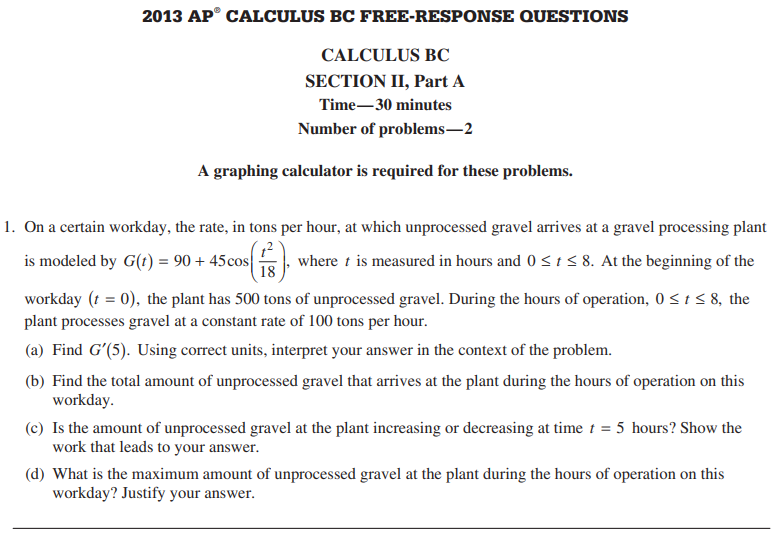AP Calculus BC 2013 Questions And Answers
Questions And Worked Solutions For AP Calculus BC 2013
Click on the following image to get the complete paper of AP Calculus BC 2013 Free Response Questions. Scroll down the page for step-by-step solutions.

AP Calculus BC 2013 Free Response Questions - Complete Paper (pdf)
AP Calculus BC 2013 Free Response Questions - Scoring Guide (pdf)
- On a certain workday, the rate, in tons per hour, at which unprocessed gravel arrives at a gravel processing
plant is modeled by G(t) = 90 + 45cos(t2/18), where t is measured in hours and 0 ≤ t ≤ 8.
At the beginning of the workday (t = 0) , the plant has 500 tons of unprocessed gravel. During the hours of
operation, 0 ≤ t ≤ 8, the plant processes gravel at a constant rate of 100 tons per hour.
(a) Find G′(5). Using correct units, interpret your answer in the context of the problem.
(b) Find the total amount of unprocessed gravel that arrives at the plant during the hours of operation on this workday.
(c) Is the amount of unprocessed gravel at the plant increasing or decreasing at time t = 5 hours? Show the work that leads to your answer.
(d) What is the maximum amount of unprocessed gravel at the plant during the hours of operation on this workday? Justify your answer. - The graphs of the polar curves r = 3 and r = 4 2sin q are shown in the figure above. The curves intersect
when θ = π/6 and θ = 5π/6.
(a) Let S be the shaded region that is inside the graph of r 3 and also inside the graph of r = 4 2sin θ Find the area of S.
(b) A particle moves along the polar curve r = 4 - 2sin θ so that at time t seconds, θ = t2. Find the time t in the interval 1 ≤t ≤ 2 for which the x-coordinate of the particle’s position is -1.
(c) For the particle described in part (b), find the position vector in terms of t. Find the velocity vector at time t = 1.5.
- Hot water is dripping through a coffeemaker, filling a large cup with coffee. The amount of coffee in the cup
at time t, 0 ≤ t ≤ 6 is given by a differentiable function C, where t is measured in minutes. Selected
values of C(t), measured in ounces, are given in the table above.
(a) Use the data in the table to approximate C′(3.5). Show the computations that lead to your answer, and indicate units of measure.
(b) Is there a time t, 2 ≤ t ≤ 4 at which C’(t) = 2 ? Justify your answer.
(c) Use a midpoint sum with three subintervals of equal length indicated by the data in the table to approximate the value of .Using correct units, explain the meaning of in the context of the problem.
(d) The amount of coffee in the cup, in ounces, is modeled by B9t) = 16 - 16e-0.4t. Using this model, find the rate at which the amount of coffee in the cup is changing when t = 5. - The figure above shows the graph of f′, the derivative of a twice-differentiable function f, on the closed interval 0 ≤ x ≤ 8. The graph of f′ has horizontal tangent lines at x = 1, x = 3, and x = 5. The areas of the regions between the graph of f′ and the x-axis are labeled in the figure. The function f is defined for all real numbers and satisfies f(8) = 4.
(a) Find all values of x on the open interval 0 < x < 8 for which the function f has a local minimum. Justify your answer.
(b) Determine the absolute minimum value of f on the closed interval 0 ≤ x ≤ 8. Justify your answer.
(c) On what open intervals contained in 0 < x < 8 is the graph of f both concave down and increasing? Explain your reasoning.
(d) The function g is defined by g(x) = (f(x))3. If f(3) = -5/2, find the slope of the line tangent to the graph of g at x = 3. - Consider the differential equation
- A function f has derivatives of all orders at x 0. Let Pn(x) denote the nth-degree Taylor polynomial for f about x 0.
Try out our new and fun Fraction Concoction Game.
Add and subtract fractions to make exciting fraction concoctions following a recipe. There are four levels of difficulty: Easy, medium, hard and insane. Practice the basics of fraction addition and subtraction or challenge yourself with the insane level.

We welcome your feedback, comments and questions about this site or page. Please submit your feedback or enquiries via our Feedback page.